 |
|
|
|
||
Refractor Telescope Kit |
||
For those wanting to learn how to make and use a “Small, Simple, Beginner’s Telescope Anyone Can Build.” Adults—Youngsters—Class Projects This is NOT a kit of parts that you assemble—you make everything from the telescope lenses to the tripod. NOTE: Very limited quantities—PLEASE READ the statement below in ORANGE. |
||
Alan Binder, Ph.D. and Ken Graun have created a basic telescope kit for anyone wanting to try their hand at building a simple refractor telescope and explore the heavens. The kit includes the basic materials to grind and polish a 1.75 inch diameter refractor lens (with a clear aperture of 1.5 inches) along with two eyepieces that yield 30x and 60x. A few of the basic telescope components are also included, like the cells for the objective lens and eyepieces. But, the materials for the tube and tripod are to be purchased and constructed by the telescope maker. The intent of this kit and instructions is to provide a means to build and learn the fundamentals of telescope making—to go through the whole process from start to finish. Additionally, the manual contains a plethora of celestial objects that can be observed with the telescope. We hope to incourage individuals to learn and enjoy telescope making and observational astronomy. |
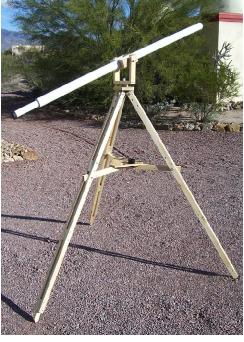 |
GETTING STARTED TO ORDER THE KIT |
||||||||||||
Although this kit sells for just $20, the cost of this kit is well below our actual cost. And, it is very time consuming for us to create all the pieces provided in each kit. For this reason, we ask that your purchase of the kit be a serious consideration. Additionally, we cannot provide kits for whole classrooms, so we ask teachers to purchase one kit and make it a class project. As a class project, every student should be able to find some aspect that he or she can contibute towards the completion of the telescope. |
||||||||||||||
The completed 1.5 inch diameter refractor. |
||||||||||||||
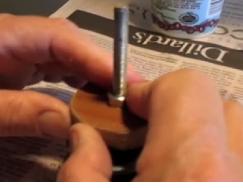 |
||||||||||||||
Questions & Answers What does the kit contain? What type of telescope would be made? What does this project entail? What tools will I need? What instructions are provided? 1) Very comprehensive instructional manual, with pictures and drawings, that can be downloaded from this page (to the right at the top of the yellow box). 2) Videos on YouTube showing the various stages of making the lenses and other construction. Links are in the yellow box to the right. 3) Dr. Alan Binder and Ken Graun are available to answer questions. What is the purpose of this kit? This telescope kit was conceived by Alan Binder, Ph.D., one of the world's leading lunar and planetary scientists, whose spacecraft, Lunar Prospector, orbited the Moon from 1998 through 1999. Dr. Binder has made several telescopes, including his favorite, a 17-foot long, 2.8 inch diameter refractor patterned after a late 1600s telescope similar to one used by Johannes Hevelius. Dr. Binder wrote the manual to build this refractor. Ken Graun worked with Dr. Binder in the development of this project and has also made several telescopes. |
||||||||||||||
Grinding the front objective lens. |
||||||||||||||
Project Resources Instructional Videos on YouTube — click on each Video 1 • Introduction by Alan & Ken Video 3 • Grinding & polishing the plano side of the objective lens. Working with pitch for polishing. Video 4 • Grinding the objective lens convex Video 5 • Measuring the focal length of the objective Video 6 • Grinding the eyepieces Video 7 • Assembling the telescope Video 8 • Making the mount and tripod Plans to make a stand for the electric hand drill Contacts Dr. Alan Binder abrbprospector@earthlink.net Ken Graun ken@kenpress.com |
||||||||||||||
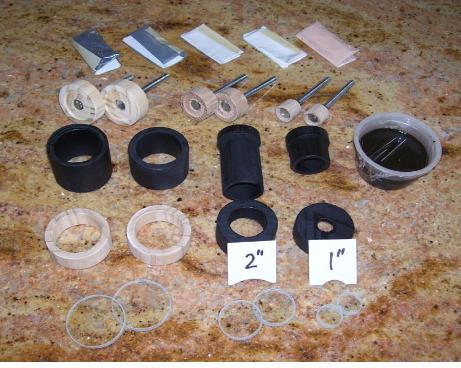 |
||||||||||||||
Kit contents. Includes lens blanks to make the objective and two eyepieces (bottom row), grit, polishing compound and pitch to grind and polish the lenses (top row & cup on right), drill spindles to attach lenses for the grinding and polishing process (2nd row from top), wooden objective cell and two wooden eyepiece barrels (2nd & 3rd rows from bottom).The pieces of paper with 1" and 2" written on them have curves cut in them and serve as templates when grinding the eyepieces. |
||||||||||||||
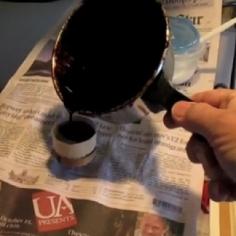 |
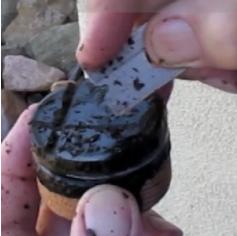 |
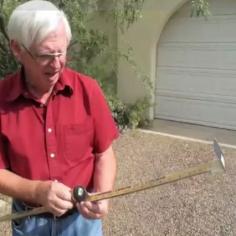 |
||||
Measuring the focal length of the objective using the concave tool as a "mirror." |
||||||
Pouring pitch to make a pitch lap which is used to polish the lenses. |
Cutting a channel in the pitch lap which ensures better polishing. |
|||||
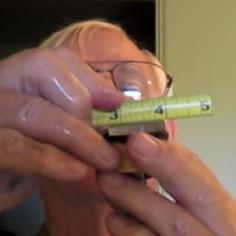 |
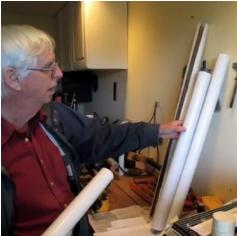 |
 |
||||
The progress of grinding the curvature in an eyepiece lens is determined by using the straight edge of a tape measure. |
||||||
The tubes used to assemble the actual telescope. |
Aiming the telescope is accomplished by sighting along the tube. |
|||||